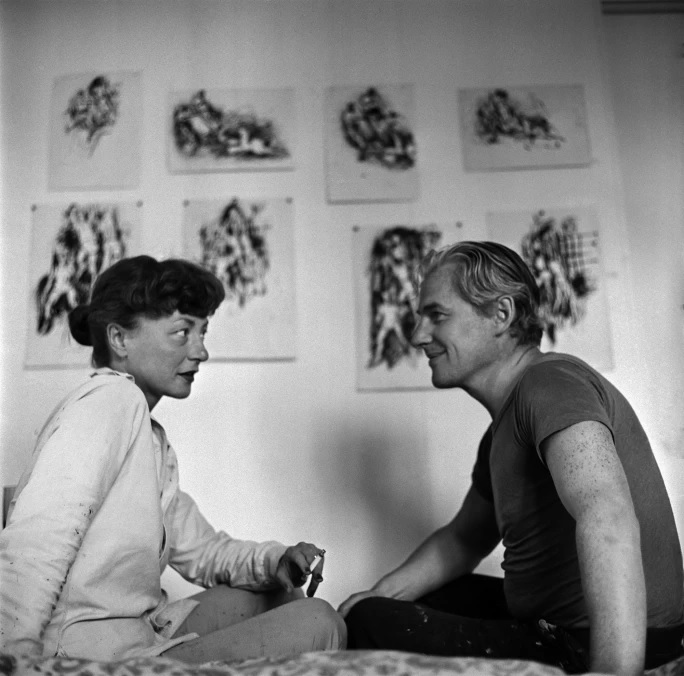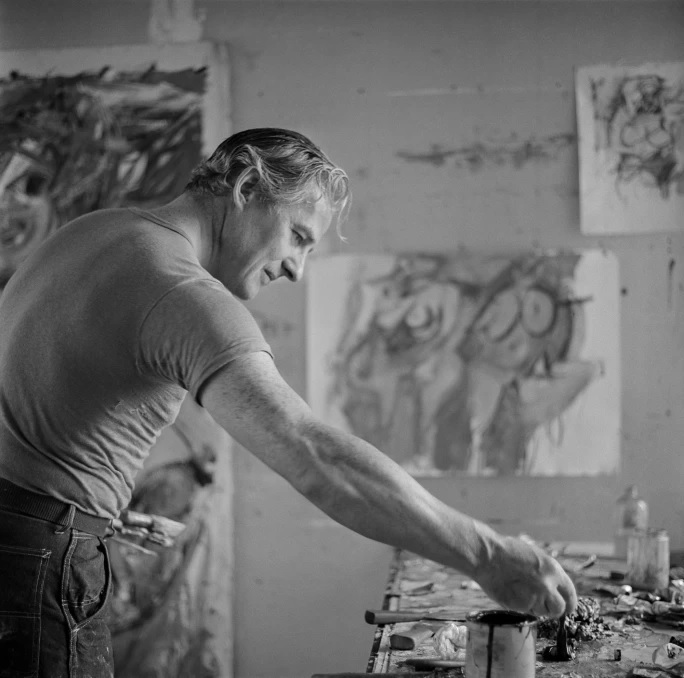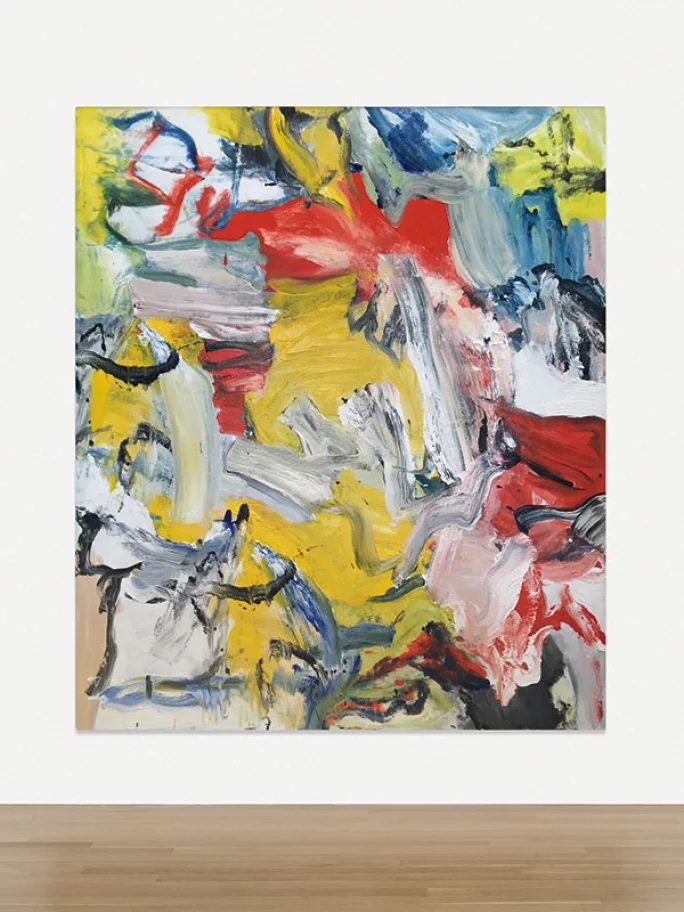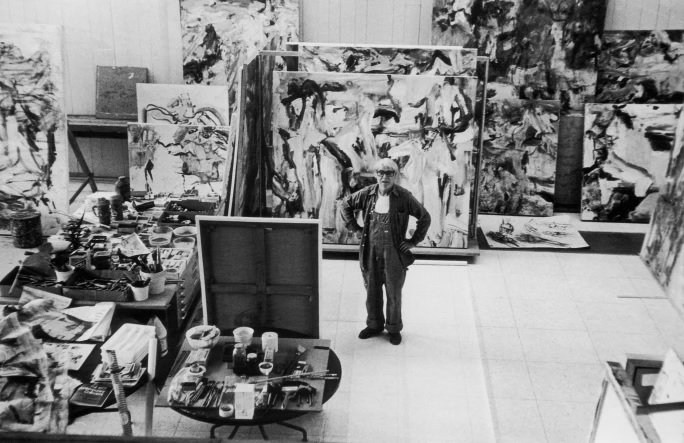1.Born in Rotterdam, the Netherlands, Willem de Kooningleft school to begin working when he was only 12 years old, taking an apprenticeship at a design and decoration firm.
2. De Kooning immigrated to America illegally, as a secret stowaway on a ship in 1926.
3. He began working for the WPA Federal Art Project in 1935, but left after less than two years due to his lack of citizenship and fear that he would be found out.
4. Beginning his career at around the height of Pablo Picasso’s fame, De Kooning, like many contemporaneous artists, had trouble in the beginning of their careers competing with the Parisian avant-garde art scene; he commented, “Picasso is the man to beat.”
5. Preeminent and renowned art critics Harold Rosenberg and Clement Greenberg were fans of De Kooning’s work, and their reviews and commentary on his work propelled much of his career.

Elaine and Bill de Kooning. 1953.
6. De Kooning’s future wife Elaine Fried took his drawing class in 1938 and married in 1943. Their passionate union fell victim to professional ambition, poverity, alcohol abuse and infidelities. The couple reunited in their later years, however, sharing a studio in Long Island.
7. In the early 1950s, on the advice of an acquaintance, he began consuming, and sometimes binging, alcohol to manage his anxiety and heart palpitations.
8. He was awarded the Logan Medal and Purchase Prize from the Art Institute of Chicagofor the work Excavation (1950), resulting in his first museum purchase, as the Museum acquired the work.
9. De Kooning’s oeuvre is marked by his continuous stylistic experimentation, and in 1953 he exhibited figural works known as his “Women” paintings, largely at odds with the tenets of Abstract Expressionism and his previous work. This largely led to the loss of Greenberg’s support, but, nevertheless, the Museum of Modern Art, New York, purchased Woman I(1950–52) just six months after its initial exhibition.
10. The near constant evolvement of his artistic practice confounded some critics, leading him to utter his now popular motto, “You have to change to stay the same.”

Willem de Kooning ‘Amityville’ 1971.
11. Although he is often associated with Abstract Expressionism, he generally rejected any association with a specific movement. His introduction of figuration led some critics, including Greenberg, to consider his work regressive, leading De Kooning to quip, “Flesh is the reason oil paint was invented.”
12. He was known to frequently rework canvases, spending a great deal of time painting a canvas before ultimately scraping all the paint off, re-priming the canvas, and starting again.
13. The painter Josef Albers personally invited him to teach at the famed Black Mountain College in the summer of 1948.
14. De Kooning delivered his now seminal lecture “What Abstract Art Means to Me”at the Museum of Modern Art, New York, in 1951.

De Kooning in his studio. 1953.
15. In 1953, a then young Robert Rauschenberg asked De Kooning for one of his drawings so that he could “erase” it. De Kooning obliged and supplied him with a drawing, which Rauschenberg then methodically erased, and, along with fellow artist and friend Jasper Johns, meticulously matted and framed the work with the label, “Erased de Kooning Drawing.”
16. He moved from New York City to East Hampton, Long Island, in 1963 where he personally designed and had built a studio and home. He would settle there permanently in 1971. It was here that he met and befriended a number of high-profile individuals, including The Beatles band member Paul McCartney.

Willem de Kooning ‘Untitled XXI’ 1976.
17. He often played with the viscosity of his paints, sometimes adding water or safflower oil to make them more “slippery” and easy to apply.
18. De Kooning’s very first retrospective was held at the Museum of Fine Arts, Boston, in 1953, and just five years later he declined the Museum of Modern Art’s invitation for a major retrospective.
19. De Kooning did not become a United States citizen until 1962. He was awarded the Presidential Medal of Freedom two years later in 1964.

Willem de Kooning in his studio in East Hampton, New York, March 26, 1978.
20. His first international retrospective exhibition was held in 1968 at the Stedeljk Museum, Amsterdam. He attended the opening, which was his first trip back to his native country since leaving in 1926.
21. By 1989 he was suffering severely from dementia, necessitating his daughter, Lisa de Kooning, to be granted power of attorney. Some critics have questioned if works made after this point were “compromised” due to his mental state, but others have argued that Abstract Expressionism is intuitive, rather than intellectual.
Source: Sotheby’s







